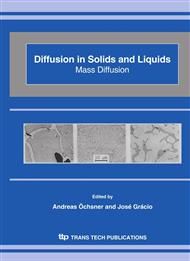p.101
p.107
p.113
p.118
p.124
p.130
p.137
p.146
p.152
The Influence of Defects on Proton Diffusion in Perovskites АIIВIV11-xRIIIxO3-δ: Monte Carlo Study
Abstract:
The tracer diffusion coefficient D* and the mobility of protons in proton-conducting oxides of the АIIВIV 1-xRIII xO3-δ family have been calculated using the Monte Carlo method as functions of temperature and concentration x of the acceptor impurity RIII. The effect of protondopant interactions (proton trapping) and the effect of protonic sites blocking caused by protonproton and proton - oxygen vacancy interactions, are analyzed. It is shown that the proton diffusivity depends significantly on the dopant content and is considerably reduced already at small x. The D* value weakly depends on the concentration of oxygen vacancies at fixed, not too large values of x. The conductivity dependence on the doping concentration σ(x) can have a maximum due to the proton-defect and proton-proton interactions. The Haven ratio deviates slightly from unity at the expected intensity of interparticle correlations. The calculated values of both the diffusivity activation energy increase (with x), and the location of the σ(x) maxima agree with the experimental data for a number of proton-conducting oxides.
Info:
Periodical:
Pages:
124-129
Citation:
Online since:
October 2006
Keywords:
Price:
Сopyright:
© 2006 Trans Tech Publications Ltd. All Rights Reserved
Share:
Citation:


